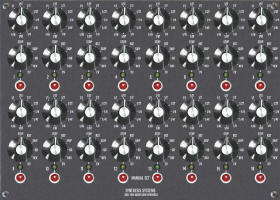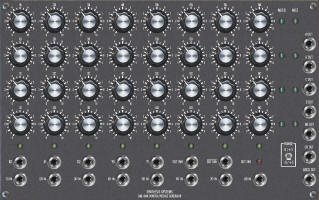elektrolabel
..
Da es neben mir auch noch interessierte gibt, hab ich mal ein wenig an infos zusammengetragen.
Supermoe setzt sich aus mehreren Modulen zusammen; ich besitze von Moe 2 x DAB1084, Frontpanel Daten zu DAB-1000 und DAB-1016 habe ich selber erstellt.
Kommentare von Moe bzw. von mir zu den einzelnen Modulen und den möglichen Bauteilen im entsprechenden Modul.
Generelle Info zum Design:
"
Super Moe design splits up parts of the sequencer that are normally in the same box. The inspiration was the modular sequencer from E-Mu back in the 70s.
Normally you have a counter in a sequencer that takes a clock pulse input and counts up. The outputs of the counter are a binary number. So an 8 position sequencer uses a 3 bit counter (2 raised to the 3rd power is 8 ). Another component is called a 3 to 8 multiplexer, which takes as input a 3 bit number (from the counter) and connects one of 8 outputs to an input. This is how they select a row of pots to turn on.
In my system (and the E-MU), the counter is separated into a different module than the multiplexer. The panels you bought are for a multiplexer which controls 4 rows of 8 pots. So the 3 counter inputs that make up the binary number are X0, X1, and X2.
The advantage of this is expandability. You can mult together X0, X1, and X2 from more than one multiplexer, then let them all shift together, and switch them on sequentially to extend your number of steps."
DAB-1016 Counter:

Moe: " For the counter look at the 74LS193. It has the
separate up/down clock and carry/borrow inputs and
outputs already on the chip.
There are two ways to do a counter - single clock
input and a direction input, or separate up and down
clock inputs.
The reason to go with separate inputs is
expandability. If you were to build two of these
modules, and patch the carry output of the first to
the up clock input of the second, then the borrow
output of the first to the down clock input of the
second, you have just turned your 4 bit counter into
an 8 bit counter, capable of 28 states (can count to
256)."
DAB-1018A Address Generator Interface

DAB-1084 Control Voltage Generator

Schematics hier: Teil 1, Teil 2 und Teil 3
DAB-1017 Clock Controller

DAB-1000 Dual VC Clock
Ggf. dieses Design hier modifizieren:
http://www.cyndustries.com/synapse/synapse.cfm?pc=59&folder=jan1978&pic=45

Supermoe setzt sich aus mehreren Modulen zusammen; ich besitze von Moe 2 x DAB1084, Frontpanel Daten zu DAB-1000 und DAB-1016 habe ich selber erstellt.
Kommentare von Moe bzw. von mir zu den einzelnen Modulen und den möglichen Bauteilen im entsprechenden Modul.
Generelle Info zum Design:
"
Super Moe design splits up parts of the sequencer that are normally in the same box. The inspiration was the modular sequencer from E-Mu back in the 70s.
Normally you have a counter in a sequencer that takes a clock pulse input and counts up. The outputs of the counter are a binary number. So an 8 position sequencer uses a 3 bit counter (2 raised to the 3rd power is 8 ). Another component is called a 3 to 8 multiplexer, which takes as input a 3 bit number (from the counter) and connects one of 8 outputs to an input. This is how they select a row of pots to turn on.
In my system (and the E-MU), the counter is separated into a different module than the multiplexer. The panels you bought are for a multiplexer which controls 4 rows of 8 pots. So the 3 counter inputs that make up the binary number are X0, X1, and X2.
The advantage of this is expandability. You can mult together X0, X1, and X2 from more than one multiplexer, then let them all shift together, and switch them on sequentially to extend your number of steps."
DAB-1016 Counter:

Moe: " For the counter look at the 74LS193. It has the
separate up/down clock and carry/borrow inputs and
outputs already on the chip.
There are two ways to do a counter - single clock
input and a direction input, or separate up and down
clock inputs.
The reason to go with separate inputs is
expandability. If you were to build two of these
modules, and patch the carry output of the first to
the up clock input of the second, then the borrow
output of the first to the down clock input of the
second, you have just turned your 4 bit counter into
an 8 bit counter, capable of 28 states (can count to
256)."
DAB-1018A Address Generator Interface

DAB-1084 Control Voltage Generator

Schematics hier: Teil 1, Teil 2 und Teil 3
DAB-1017 Clock Controller

DAB-1000 Dual VC Clock
Ggf. dieses Design hier modifizieren:
http://www.cyndustries.com/synapse/synapse.cfm?pc=59&folder=jan1978&pic=45

